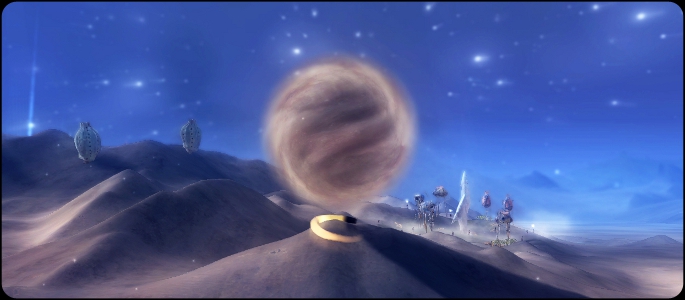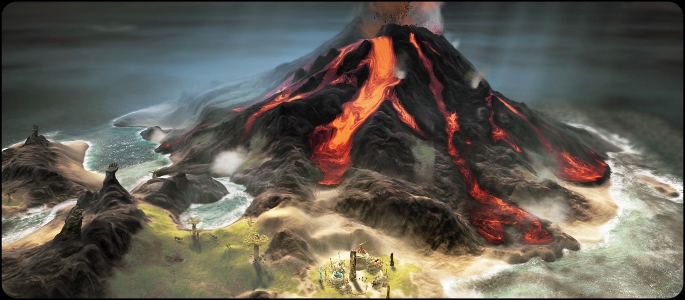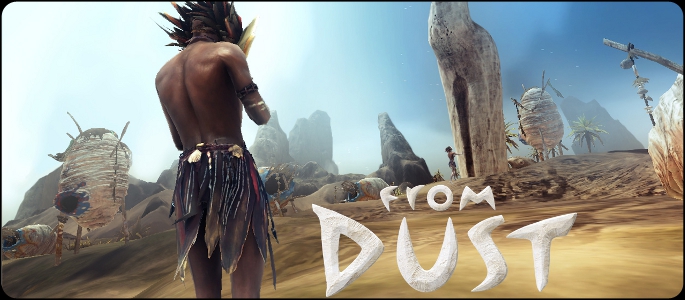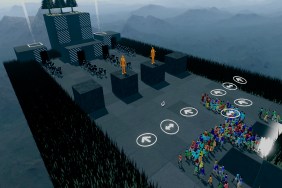It’s time to find out if the new god game from Eric Chahi, From Dust, is worth making the journey with, or should remain buried in the sand.
From Dust is most easily described as a god game, but technically players take control of the breath, a mysterious power of nature which has been summoned forth by a tribe who has no memory of their past, and is seeking their roots. The breath takes the shape of a circular cursor, which can be moved around the world to direct tribesmen where to go, as well as picking up elements of the environment to place them somewhere else, like displacing land to create a bridge, or draining a pond of its water to allow for building of a village. The game starts off simply enough, tasking players with building a bridge to allow the tribe to reach a passageway leading them to the secrets of their ancestors, but as more elements and powers are introduced, From Dust grows in complexity rather quickly.
It’s hard to play From Dust without thinking of the classic Populous games (noted, there is a reference to Populous creator Peter Molyneux within From Dust), since both games involve manipulating terrain to allow tribes to thrive in a harsh world, but From Dust sheds most of the real time strategy elements seen in Populous. Instead of worrying about building an army and training troops, players will focus much more on the terrain and getting their tribes to build predesignated villages at totem poles. Villages allow them to repopulate, and building all available villages (up to four) opens up a special passageway which serves as the exit for each level. Each of these villages may unlock a special power to help overcome the obstacles in the way, such as amplifying your power, evaporating most of the water in a level, putting out all the fires in a level, or even creating an unlimited amount of land, although with a limited amount of time to do so.

Since each power is tied to a specific totem pole, and volcanoes, floods, forest fires, and severe erosion may stand in your way, it’s important to choose wisely where to send men to build a village at first. Without the right powers or moving quickly, terrain may wash away, or a volcano may grow from a mere hill to a mountain over the course of a few minutes, and this in turn may cause any number of chain reactions throughout the land which could devastate your villages. Luckily, villages may be moved to more strategically viable areas, and stones of knowledge throughout the land can provide villagers with the ability to musically repel oncoming floods or magma flows.
Throughout all of this guidance you’ll offer to your villagers, From Dust is a treat to look at. It may not have the sharpest graphics ever seen, but the art style and coloration make it aesthetically pleasing to watch, even if what you’re watching is a volcano threatening doom on villagers, who moments later are rescued from burning by lava by a monsoon only to be swept away by the flood it in turn causes. Playing From Dust can be like having the greatest aquarium, sandbox, and lava lamp all rolled into one just for your entertainment.
Unfortunately, the campaign feels a tad on the short side, requiring only about six hours to play through all the storyline levels. Perhaps it felt short because it left me wanting to play more, but luckily 30 challenge levels are included to play afterward, which in themselves could take another additional six hours to beat. For the most part, the objectives in the challenge levels are simpler, involving collecting knowledge from a stone within a certain time limit while redirecting the flow of water to help your runner, or using magma to shore up walls around a village suffering from severe erosion, and claustrophobia. These challenge levels never feel quite as fun as the campaign’s levels, but they do offer unique scenarios and sometimes require thinking outside the box to solve.

This is also where one of From Dust’s main faults becomes more noticeable. Often times villagers will struggle to find the best path to their destination and back, and will get stuck on terrain, or take an extremely long route instead of the short, obvious one. Most of the time, this is easily remedied by plopping some earth down along the route, but in many challenges the tight time limits make this occurrence much more annoying. You can’t manually redirect a villager’s route either, and are only able to select their destination at specific locations, leaving few solutions to this issue. Luckily the problem isn’t extremely prevalent, but if it happens at the wrong time it’s still mildly infuriating.
Overall, From Dust is a good game worth playing through, and provides entertainment in a way that easily sets it apart from most other PSN games available. The combination of aesthetic beauty and environmental manipulation make for a relaxing and pleasing game that also manages to keep you on your toes, thanks to the chain reactions that may be caused by subtle changes. The pleasing puzzles present unexpected challenges, and even when they’re over it’s still fun to just toy around with. It leaves me hoping that Chahi and his team continue to build on the foundation laid here, so we can explore deeper and more complex levels in this living sandbox.
PlayStation LifeStyle’s Final Score
+ Beautiful visual direction + Fun environmental puzzles – Clunky villager AI |
 |
–








